
Before discussing the best pen for quilt labels, let’s define quilting first. A quilt is a textile or garments layered together to create a stunning art on a piece of cloth. Most often, a quilt has three layers of fibers woven together.
Quilting is more than an act of art, it can be a very good source of income. Anyone can make a business out of it.
The beauty relies on strategic stitching techniques. Different colors can be used to satisfy certain artistic taste.
Quilts serve many purposes. But traditionally, they symbolized honor, greatness, love, hope, and freedom. This is the reason why people usually use quilts as gifts for newly-wed couples as a way to congratulate them as they enter the new chapter of their lives.
However, in the modern day, quilts are normally used for bedding and for other decorative purposes. You normally see these in the homes of people who have an intricate sense of artistry.
Quilting requires special tools. The most common one is the pen. Quilting requires a special type of pen that could deliver the job you want. Because you are working with fabric, not all pens may work well. So, what is the best pen for quilt labels?
Related: Fabric Markers: The Best Pen For Writing On Fabric
Well, the answer may depend on the user. Some people prefer cheaper pens like JetPens. JetPens are not only cheaper but also reliable. They can deliver the performance you are looking for.
Aside from JetPens, others love the Sakura Roll Pens and Pigma Micron pens. The performance of these pens may be dependent on the type of job you are doing as well as the type of fabric you are working with.
Different types of pens have different types of ink characteristics and nib sizes. These features will surely affect your artwork.
But the most important consideration when working with a piece of fabric is that the ink of your pen must not bleed and fade. So I did a research online as well as asked people who do quilting about their most favorite and best pen for quilt labels.
The most common pens being used are the Sharpies with fine points and the Pigma pens. These pens are reliable and durable. The ink does not fade and bleeds when used on the fabric especially on complex design.
But more than half of the people I asked said they love the Sharpies more than others. However, the common suggestion is that you need to make sure that whatever ink you’re using must not fade when washed.
Although Sharpies are what most people pick, the users recognize the possibility that not all Sharpies work well in a given project. Different fabrics may require different types of pens. Also, different fabrics absorb the ink differently.
Related: Best Pen For Writing On Wooden Plaques
In short, finding the best pen for quilt labels depends on the type of materials you are using.
But aside from pens, you can use computers and printers for your project. You can buy these things on Amazon. Many embroidered patterns and labels are also available online. You can buy as you need them.
But some people really love the personal touch. So they make their quilts by hand to keep that real, authentic, and caring feeling especially if it is for a gift.
Some of the things you see on personalized quilts are motivational quotes, Bible verses, and the name of the quilters as well as the date when it’s made.
But of course, you can include anything you want. The number of designs you can use is limitless. Your creativity is only the limit.
If you need inspiration, search online for patterns that you may like. Sometimes, the best art comes from innovation. You don’t have to be one hundred percent original. All you have to do is to pick up some designs that you like and create your own version of it.
There you go, I hope I’m making sense here. Although I give you the idea of how to pick the best pen for quilt labels, the decision is yours.
Determine your own preference and the materials you are about to use. These things must be considered before you start dealing with your art. Good luck quilters!
